Cluster quartet probes the secrets of the black aurora
10 December 2001
Anyone living near the Arctic Circle will be familiar with aurorae, the legendary red and green curtains that illuminate the long winter nights. Much less familiar is the mysterious 'black aurora', a strange electrical phenomenon that produces dark, empty regions within the visible Northern and Southern Lights.
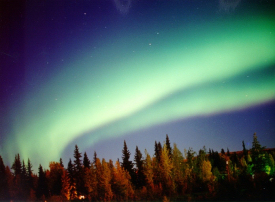 |
| Aurora. Credit: Jan Curtis, Fairbanks, Alaska |
In an effort to solve the puzzle of the black aurora, Swedish and British researchers have used the four Cluster spacecraft to make the most detailed observations yet of the regions where they are generated.
The black aurora takes on various guises - dark rings, curls or black blobs in a sea of faint, glowing aurora. According to the new results, to be announced today at a meeting of the American Geophysical Union in San Francisco, these peculiar patches are caused by a kind of 'anti-aurora', where conditions are the exact opposite of those in the normal aurora.
The Cluster data show that the black aurora occurs where there are holes in the ionosphere(*), the part of the upper atmosphere where aurorae are created. Here, the particles that make up the ionosphere are shooting upwards into space inside regions known as positively charged electric potential structures.
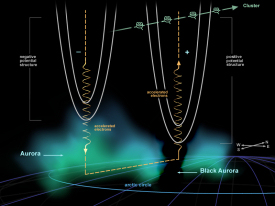 |
| The four Cluster spacecraft showed that black aurorae are a kind of 'anti-aurora'. Credit: ESA. Illustration by Medialab |
This is the opposite process to that which creates visible aurorae, where electrons spiral down from space into the atmosphere within similar, but negatively charged, structures.
"The black aurora isn't actually an aurora at all; it's a lack of auroral activity in a region where electrons are 'sucked' from the ionosphere," explained Professor Göran Marklund of the Alfvén Laboratory in Sweden.
"Now, with the aid of the four Cluster spacecraft, we have been able to study for the first time the complex physical processes that create these auroral holes," he said. "Cluster has allowed us to discover how the huge vertical structures associated with the black aurora form, how long they last and how they vary with altitude."
Cluster's string of pearls
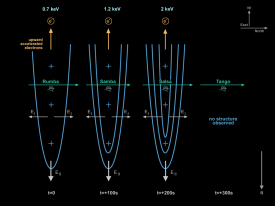 |
| Cluster indications for some changes in the magnetosphere above the black aurora. Credit: ESA. Illustration by Medialab |
The first Cluster observations of the black aurora took place on the morning of 14 January 2001 as the four spacecraft swept from south to north across the northern aurora at an altitude of more than 21 600 km.
Aligned like a string of pearls flying 100 seconds apart, the first three spacecraft (Rumba, Salsa and Samba) detected an increase in the energy of the upward-moving electrons, coinciding with an increase in the electric field that was accelerating the electrons, and a stable electric current. However, the electric field had vanished and no evidence of a structure could be seen by the time the fourth spacecraft (Tango) flew over the aurora.
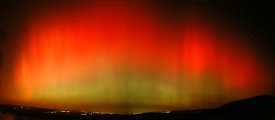 |
|
Red and green aurorae illuminating the skies near the Arctic Circle. Credit: Till Credner, AlltheSky.com |
Similar results were obtained from a crossing of the southern hemisphere auroral zone on 14 February. Once again, the electric field increased steadily in strength, but the electric current stayed constant as the quartet sped overhead.
"The data show that the potential structures that create the black aurora extend to altitudes greater than 20 000 km and that they grow in size and intensify over timescales of a few minutes," said Professor Marklund. "It is as if the 'cosmic battery' was getting stronger and stronger and then suddenly stopped working after about 3-4 minutes."
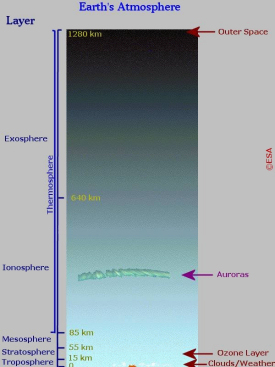 |
|
Diagram of the Earth's atmosphere. Credit: ESA |
"This period of growth is comparable to the time it takes to 'suck' the electrons from parts of the ionosphere," said Marklund.
"This is the first time that we have been able to follow the evolution of these structures as they accelerate the electrons away from the auroral ionosphere," he added.
"Understanding the development and growth of these dynamic structures associated with the aurora is a major goal of the Cluster mission, and something which cannot be solved by single satellite measurements," he concluded.
The results will be published in the journal Nature on 13 December 2001.
(*) The ionosphere is a sparse layer of atmosphere, between 60 km and 600 km above the Earth, that reflects radio waves. It is filled with billions of particles - negatively charged electrons and positively charged ions.
Another Cluster result, "Cluster Tunes Into Earth's Frequency, Pinpoints Location of Auroral Radio Emissions", will be presented today at the American Geophysical Union meeting in San Francisco. Further details are available at: http://istp.gsfc.nasa.gov/istp/news/0112/fall01agu.html. See also the related link to "Cluster pinpoints auroral radio emissions" at the right-hand side.
For more information please contact:
Dr. Philippe Escoubet, ESA - Cluster Project Scientist
ESTEC - Noordwijk, The Netherlands
Tel: +31 71 565 3454
E-mail: Philippe.Escoubet esa.int
esa.int
Prof. Göran Marklund
Division of Plasma Physics
Alfvén Laboratory, Royal Institute of Technology
Stockholm, Sweden
Tel: +46 8790 7695
E-mail: marklund plasma.kth.se
plasma.kth.se





